|
Four hundred fifty-six players played 100 minutes or more in the NBA last season. Ninety-two of those 456 (20 percent) were not drafted at all, while 100 (22 percent) were second-round picks. There will be quite a few players from this draft class who will carve out long careers in the league, despite not hearing their names called by Adam Silver on Thursday. The challenge for teams (and us) is to identify which ones. Anyone can tell you that Deandre Ayton, Marvin Bagley III or Luka Doncic should be good NBA players for a long time. Being able to identify the next Nikola Jokic and Draymond Green in the second round -- or Wesley Matthews and Fred VanVleet in the pool of undrafted free agents -- is where the league's best talent evaluators truly show their stripes. It's usually role players -- deemed to be the least upside laden -- who fall in this range. So we revisited a piece from earlier this year on finding elite role-players to see which archetypes the NBA is most actively seeking and then figure out which players in this year's crop might fit that bill. We looked strictly at players who aren't currently projected to be drafted in the first 30 picks of our latest mock draft. We've also included projected wins above replacement (WARP) and rank in Insider Kevin Pelton's stats-only draft projections, which do not factor in our rankings.
Justin Jackson | SF/PF | Maryland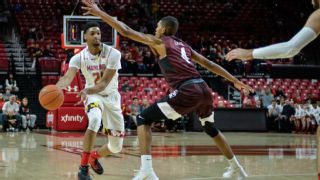 Potential role: Two-way combo forward Why he fits: Jackson fits the physical component of the two-way combo forward archetype perfectly, standing 6-foot-6 barefoot, with a 7-foot-3 wingspan and 229-pound frame. Our historical measurements database (which has more than 9,000 entries) tells us he's almost an exact match to Kawhi Leonard physically, with OG Anunoby being his second-closest comparison. Rudy Gay and Draymond Green aren't far behind. Jackson has the frame, length and reach to see some minutes at the center position even in small-ball lineups, even if he never got a chance to show that in college, where he saw quite a few minutes at small forward. Jackson was projected as the No. 14 pick in the draft after a strong showing at the Adidas Nations camp in Houston in August, scoring 44 points in 84 minutes (6-of-11 on 3-pointers) against top-level competition. Unfortunately, a torn labrum he suffered after the camp completely derailed his sophomore season. According to sources close to Jackson, he was encouraged by the Maryland coaching staff to fight through the injury, playing 11 games, until getting a second opinion and being advised he would be wise to have surgery. The damage was already done by then, as his jumpshot had completely abandoned him (his 3-point percentage dropped from 44 to 25 percent), and his draft stock cratered. Jackson still hasn't been cleared for five-on-five competition (that will reportedly happen in the next few weeks), and he's largely out of sight, out of mind at this stage. Considering the type of injury he was playing through, it seems like holding his 3-point shooting numbers against him doesn't make a great deal of sense after he made 40-90 spot-up jumpers as a freshman while showing good shooting mechanics. Even if Jackson regresses to the mean and ends up being just an average 3-point shooter in the NBA (he hit 73 percent of his free throws in college, a solid figure), he could still have quite a bit of value considering the playmaking ability he brings on the defensive end. Jackson averaged 9.4 rebounds, 1.2 blocks and 1.2 steals per-40 minutes in college, despite mostly guarding perimeter players. One NBA executive told us that he has identified Jackson's college coach at Maryland, Mark Turgeon, as having one of the most glaring lists of players who exceeded their collegiate production in the NBA, potentially leading to a market inefficiency. Some of Turgeon's past players include Khris Middleton (No. 39), DeAndre Jordan (No. 35), Alex Len (No. 5, but hasn't really panned out), Donald Sloan (undrafted, played five seasons in the NBA), Gal Mekel (a middling player at Wichita State, who vastly exceeded those expectations as a pro), and most recently Kevin Heurter, whose stock exploded once he left Maryland and was seen in other settings. While Jackson has plenty going for him already in terms of his measurements and 3-and-D potential, this is another factor teams will likely want to consider in terms of projecting him to the NBA. Key stat: Career 80-209 (38 percent) from 3 in 79 games; 41 percent if ignoring his 11-game injury-riddled sophomore season. Drawbacks: At 21.3 years old, Jackson is older than a handful of juniors projected to be drafted. The fact that he only has 43 games of college experience underneath his belt isn't ideal. Jackson's 44 2-point percentage in college, combined with his poor passing metrics (8 assist percentage, 16.8 turnover percentage) indicate some red flags in regards to his feel and ability to make decisions with the ball in his hands, something that is backed up on film. While a capable spot-up shooter, Jackson has traditionally struggled shooting the ball off the dribble. Jackson is more long and powerful than he is freakishly athletic, being somewhat mechanical in his movements, and likely rendering him better suited for the power forward and center positions in the NBA than on the wing like he played most of his career. Pelton projections: 0.3 WARP (No. 51)
Jevon Carter | PG | West VirginiaPotential role: Agitator Why he fits: Carter was one of the best defenders in college basketball, being the centerpiece of West Virginia's full-court press. No one did a better job of slowing down Trae Young in the Big 12. He picks up 94 feet, is a menace in the passing lanes and generally makes life difficult for opponents. He brings tremendous toughness and physicality to the table in everything he does, making him an ideal practice player and culture guy. Coaches that have worked with him swear by him. Having an extra foul at his disposal in the NBA, along with the fact that he won't be asked to play anywhere close to the 35 minutes per game he did as a senior at West Virginia, should allow him to be even more aggressive with the way he approaches his work on the defensive end. Carter developed into a capable scorer over the course of his career as well, knocking down 39 percent of his 3-pointers as a junior and senior, and is capable of making shots off the dribble. He's an unselfish player who plays at different speeds, and he will likely benefit from having more talent around him after being asked to do far too much for a West Virginia team that looked disorganized and skill-deprived at times in their half-court offense. The quality of his shot attempts will likely rise playing a smaller role where he isn't asked to take as many difficult looks as he was this past season. Key stat: 3.4 steals per 40 minutes Drawbacks: Carter isn't gifted with elite physical traits, measuring just 6-foot-0¼ without shoes with a 6-4 wingspan and average athleticism by NBA standards. Ideally you would like to see a player in Carter's mold be able to defend either guard position, but his lack of size and length might make that challenging at times. His mediocre 44 2-point percentage is partially due to his inability to create high-percentage looks for himself and teammates, as he's likely better suited playing alongside another initiator who can help handle some of the shot-creation responsibilities. He can get a little wild at times with his decision-making, picking up his dribble against pressure, settling for long 2-pointers and showing just average vision in traffic. Pelton projections: 1.3 WARP (No. 22)
Devon Hall | SG | Virginia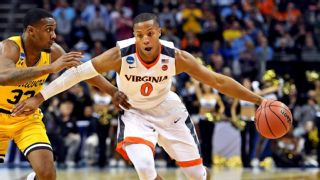 Potential role: 3-and-D style off guard/wing Why he fits: Hall brings great versatility to the table at a position and role of major need in today's NBA, being somewhat of a jack of all trades who is willing to do all the little things. He improved considerably throughout his college career, going from being a bit player as a freshman to an All-ACC player as a senior, shooting 43 percent from 3-point territory and posting a sparkling 3:1 assist-to-turnover ratio. Hall even spent time at point guard for Virginia on occasion. He was one of the best defensive guards in the college game, playing a major role in Virginia finishing the season with the No. 1 ranked defense in the country, and is big enough to guard small forwards and even some power forwards at times with his ripped frame. Hall's professional approach to the game, toughness and overall intangibles will be appreciated by coaching staffs, and that should allow him to earn a roster spot and eventually find his niche on teams that put an emphasis on culture. While not blessed with extraordinary talent, Hall has positional size, a high basketball IQ and enough chops as a shooter, defender and passer to eventually carve out a role. Key stat: 31-3 record his senior year Drawbacks: Hall is just an average athlete, and he wasn't a prolific scorer at the college level (career 11.5 points per 40 minutes). He struggles to create high percentage looks for himself. He doesn't get to the free throw line often, has difficulties finishing in traffic, and isn't the most dynamic shooter you'll find despite his lofty 3-point percentages. NBA scouts may wonder if he has enough scoring ability to stay on the floor. A poor showing at the NBA combine made some teams question how much of Hall's tremendous senior season (a major outlier in his career overall) was a product of Virginia's unique system. Pelton projections: -1.1 WARP (No. 80)
Hamidou Diallo | SG | Kentucky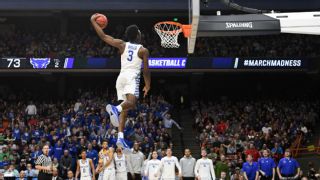 Potential role: 3-and-D wing Why he fits: Diallo is the prototype for what NBA teams are looking for at the wing position, standing 6-6, with a near 7-foot wingspan, a frame that will fill out in time and thermonuclear athleticism. His shooting mechanics are far from broken, and he showed marked improvement with his jumper over the past two years, completely revamping his mechanics. He has always been described by those around him as an incredibly hard worker who has little interests outside of basketball. Diallo's defense was inconsistent, but he improved as the year moved on; late in the season, Diallo had some remarkable stretches where he looked like one of the best wing defenders in the college game. When Diallo is fully engaged and operating at full intensity, he flies all over the court, covering ground exceptionally, getting in the passing lanes, chasing down blocks and showing multi-positional versatility. Players with comparable length are frequently asked to defend power forwards at times in today's NBA, and while his frame looks to be a long ways away from doing so, it is not out of the question considering his youth. Despite spending a year and a half in Lexington, Diallo still hasn't turned 20 and is the same age or younger than many of the freshmen projected to be picked. Considering his offensive limitations, there's a case to be made that he was in one of the worst situations of any prospect in this draft in terms of highlighting his deficiencies, playing the shooting guard position while being surrounded by non-shooters. Key stat: 7-foot wingspan, 44½ inch vertical leap, 19.8 years old, 34 3-point percentage as a redshirt freshman Drawbacks: Diallo was far from a productive player this past season, looking borderline unplayable at times during the SEC conference slate. His feel for the game leaves a lot to be desired, as evidenced by him averaging more turnovers than assists this season, a testament to his unrefined ball-handling ability and court vision. Diallo's 62 free throw percentage was not encouraging despite showing improvement as a shooter overall this past season, hinting at his struggles with the mental side of the game, especially in terms of how much his confidence fluctuates. He won't even look at the basket at times and makes poor, baffling decisions at times. Although Diallo could potentially be a great defender in time, he was inconsistent in this area at Kentucky, not always playing with the type of intensity level you'd like to see. Pelton projections: -1.0 WARP (No. 79)
Anfernee Simons | SG | Team Breakdown Potential role: Bucket-getter Why he fits: Simons has strong physical tools: big hands, a long wingspan and quick-twitch athleticism. He's explosive in the open court, putting his head on the rim effortlessly on many of his dunk attempts. He's also smooth, fluid and dynamic in his movements, being particularly impressive with the way he changes speeds gracefully. Simons looks young in the face, and may not be done growing, being a late bloomer who was very much off the radar up until 14 months ago. Simons is an instinctive scorer and natural shot-maker who has terrific balance, footwork and touch on his jumper, being equally as dangerous shooting off the dribble as he is off the catch. He has great range and confidence in his jumper, doing a great job of creating separation sharply with tight ball-handling skills and change-of-pace crossovers. He shot 80-178 from 3 (45 percent) in 25 games this season, according to Krossover. While more of a scorer than a facilitator, he does show some potential with his ability to get teammates involved unselfishly, possibly being able to develop into more of a combo guard in time. He has quick feet and long arms defensively, as well as good instincts getting in the passing lanes. You normally don't find players with this kind of talent and upside in the second round -- many teams could consider him a classic "swing for the fences" type pick, with little downside should he not pan out. Key stat: No. 9 prospect in ESPN high school recruiting rankings. Drawbacks: Simons is a project in every sense, as arguably the least-experienced player in the draft. He is attempting to be one of the first players in a while (along with Thon Maker) to go straight from high school to the NBA, after doing a post-graduate year at IMG Academy, where he wasn't always a dominant player against a fairly low level of competition. His body is a major work in progress at just 183 pounds, and looks at least two years away from being able to hang with real NBA players, meaning he'll need to spend a good amount of time in the G League. Simons measured 6-2¼ without shoes, making his size best suited to play point guard, although he's more of a 2. Simons can be somewhat of a passive player on both ends of the floor. He lacks strength, toughness and discipline defensively, which is one of main things that will keep him off the floor in the NBA for at least a year or two most likely. He's not aggressive enough using his terrific athleticism to slash to the rim and make plays around the basket, settling for floaters too often and struggling to finish through contact. (He only got to the free throw line 3.4 times per game, according to Krossover). He has a low release on his jump-shot, which makes it easy for opponents to contest when closely defended. Simons also hasn't had a great pre-draft process, passing up opportunities to showcase his upside in all-star settings like the Nike Hoop Summit and Jordan Brand Classic, which were heavily attended by NBA executives. His workouts have drawn mixed reviews. Pelton projections: N/A --Givony
Bruce Brown | G | Miami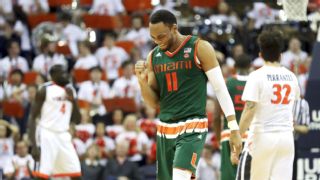 Potential Role: Utility guard Why he fits: Brown's ability to defend both guard, attack defensive rebounds, get downhill with physicality in space and facilitate in second-side situations should allow him to carve out a role utility guard. More of an unheralded role-player early on, Brown is used to doing the dirty work. He's valuable holding up against the modern NBA's many switches, and he's one of the toughest defenders in the draft. There's more to Brown's game than just defense, though, as his injury-riddled sophomore season isn't indicative of the type of offensive player he can become. He may never be wired to score, but heading into his sophomore season after a strong showing at Adidas Nations in Houston, Brown looked every bit of a first-round lock. Over five games in Houston, Brown averaged 26.4 points, 3.1 assists, 2.5 steals and 0.6 turnovers per 40 minutes while knocking down 12-26 3s. His draft stock was trending up as he built on a strong freshman season, and there should be optimism that he can trend closer to those efficiency numbers at the NBA level. Key stat: 8.4 rebounds and 4.8 assists per 40 minutes Drawbacks: For Brown to unlock his role player potential he'll have to hit catch-and-shoot 3s, which he struggled mightily to do during the 19 games he played this past season prior to injury. After finishing in the 88th percentile on catch-and-shoot jumpers as a freshman and shining from the perimeter at Nations last summer, Brown plummeted to 26.7 percent from 3, 62.9 percent from the free throw line and the 16th percentile on catch-and -shoot jumpers as a sophomore. There also are concerns about Brown's ability to improve as a scorer in the half court (he turns 22 in August). Pelton projections: -0.7 WARP (No. 74)
Shake Milton | Wing | SMU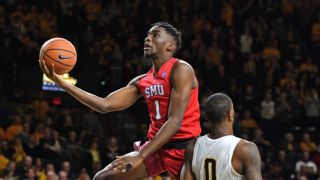 Potential role: Skilled wing Why he fits: Miscast as a big point guard early in his career, Milton is much easier to appreciate for his productivity and talent as a big, long wing who can shoot, handle and pass. It's rare to find a second-rounder with his size and length who averaged 18.0 PPG, shot 43.4 percent from 3 and posted a 1.92 assist-to-turnover rate at age 21. Although he's not the most dynamic off-the-dribble shooter because of his release point and lack of elevation, Milton is deadly with his feet set. He finished in the 98th percentile in spot-up situations (121 possessions) according to Synergy sports. He can attack closeouts into a 1-2 dribble jumper, get to floaters or kick out. While not overly quick with the ball, he's also comfortable playing pick-and-roll with the size to see over the top. His strong frame and long arms allow him to at least hold up against switches defensively and hand-contest jump shots. He improved every season at SMU and should continue to add more to his game at the next level, even if he'll never be an explosive athlete. Key stat: 98th percentile in spot-up situations Drawbacks: Milton's lack of athleticism and struggles getting to his jump shot off the dribble really showed at the combine in Chicago, where he shot 0-for-12 from the field with four assists and five turnovers in 41 minutes. Milton isn't a threat to sprint off of a screen or rise up off the bounce against long defenders, making him somewhat one-dimensional in the half court. The fact that he can pass does help him, but his lack of dynamic shooting and below-the-rim finishing are certainly causes for concern. Then there's the defensive component. Milton can play with more fire on and off the ball. Although long, he doesn't always move well and he will have to at least hold his own on defense to fill an NBA role. Pelton projections: 1.0 WARP (No. 30)
Kevin Hervey | PF | UT-Arlington Potential role: Stretch forward Why he fits: Hervey brings length, tremendous scoring instincts and a versatile shooting stroke from deep. His career 31.9 3-point percentage is a bit misleading, as his shot selection as a high-volume scorer in college certainly played a role in his bouts of inefficiency. He has more of a natural passing feel than he showed in college, and when thrust into more of a complementary role at the NBA level his percentages should rise. He's a threat from 3 spotting up in transition, he can pick-and-pop to space in the half court, he's capable of shooting off the bounce if run off his spots and he can punish a switch in the mid-post with face-up jumpers. He has ample size to play the 4 in today's NBA, and he's able to use his length effectively on defense when fully engaged. Although not a physical defender, he vacuumed 11.6 rebounds per 40 minutes in 111 career games at UT-Arlington, which bodes well for his ability to survive on the interior. Hervey would likely be getting some late first-round buzz if it weren't for concerns revolving around his ACL history. Key Stat: 2.9 made 3s per 40 minutes Drawbacks: Hervey has torn both of his ACLs and could very well go undrafted because of the injury concerns. The hope is that an NBA medical staff can hep him be more durable. The fact that he doesn't rely on athleticism to get much done bodes well for him moving forward. On the flip side, Hervey does lack a degree of toughness, as he's far too laid back on the defensive end and opts to live on the perimeter offensively. He didn't always have the best chemistry with his teammates in college and he can certainly be a bit trigger happy, which he'll have to tone down as an NBA role player. Pelton projections: 1.6 WARP (No. 17)
Issuf Sanon | PG/SG | Olimpija LjubljanaPotential role: Change-of-pace combo guard Why he fits: The second-youngest player in the draft, Sanon is an ultra-aggressive, confident combo guard who has the physical tools, intensity and budding skill teams should want in the second round. Sanon has excellent size and solid explosiveness. He loves to get downhill going right and should be able to put pressure on the rim with NBA spacing. He's a capable -- yet still improving -- shooter off the catch and the dribble, and he has some natural passing instincts despite not being the best decision-maker. Where he'll be able to make an instant impact is on the defensive end, as he pressures the ball relentlessly with the foot speed to stay in front and the frame to shed contact. He's more of an upside play than the ready-made contributors on this list, but given his lack of high-level experience up until this point, there's optimism that he can continue to improve as he develops with storied Slovenian club Olimpija Ljubljana. Key stat: 2.8 steals per 40 minutes in 53 career games Drawbacks: Sanon is very much still learning how to play the point guard position, with a raw handle and little understanding of how to blend scoring and facilitating. He over-dribbles on the perimeter, icing out teammates at times, and he's extremely right-handed in his attack. Would Sanon stand out as much if he were in an NCAA setting surrounded by American guards? Although physically ready to defend his position, Sanon doesn't have the feel to thrive at the NBA level yet. He's an erratic shooter, and he doesn't quite have the skill base to fall back on consistently. It will likely take him a few years before proving his sleeper status, but there's a lot to like about his long-term outlook, especially given his extreme confidence. Pelton projections: N/A
Rodions Kurucs | Forward | Barcelona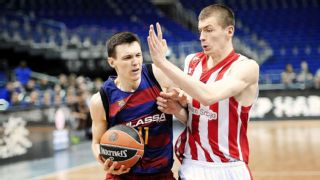 Potential Role: Versatile combo forward Why he fits: There's value in a tall forward with a long reach who can get out in transition, space the floor off the catch and attack a closeout. Kurucs was dealt a tough hand over the last couple years, as he's battled injuries and been shuffled in and out of the lineup in Barcelona, spending most of his game action with the second team in LEB Gold. The former 2015-16 Adidas Next Generation Tournament MVP has has played only 903 combined minutes over the last two seasons. Marvin Bagley played 1,118 minutes as a college freshman. However, there's still plenty of talent here. He's an intriguing option as a bench small-ball 4. His recent change in contract situation in Barcelona will also make his future development much easier. Kurucs' camp was able to get his buyout significantly lowered, allowing a team to bring him over next season or find a new home for him to develop in Europe. Kurucs lost far too much key time sitting on the bench in Barcelona, so this added flexibility is huge for his growth potential. It's not out of the question that Kurucs -- once considered a potential lottery pick -- turns out to be the best international prospect in the draft after Doncic. Key stat: 2.1 made 3s per 40 Drawbacks: Kurucs needs to get tougher (and stronger) to play consistent minutes at stretch 4. He's not the most aggressive rebounder, and he doesn't love contact on either end of the floor, struggling to guard on the interior and shying away from contact in the paint. His feel for the game can also stand to improve, as he plays a bit sped up offensively (more career turnovers than assists) and gambles regularly defensively. He's not the most polished ball handler, regularly trying to get to his right hand and struggling to change speeds or directions against a set defense. Although a capable shooter with his feet set, he's not all that dynamic, and he's only a lifetime 31.5 percent 3-point shooter on 292 attempts, which will have to be his clear NBA skill. While Kurucs' situation in Barcelona was far from ideal, his lack of consistent production at the lower level is a bit concerning. Pelton projections: N/A --Schmitz
|

